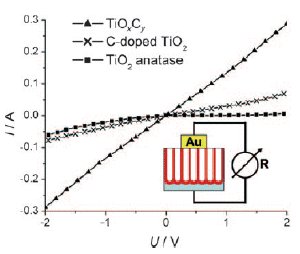Home > Press > Conducting Tubes
 |
Abstract:
Carbonized titanium dioxide nanotubes with semimetallic properties increase the efficiency of methanol fuel cells
Conducting Tubes
Germany & Finland | Posted on September 8th, 2009Mention of nanotubes usually means carbon nanotubes. But not all tiny tubes are made of carbon. For example, layers made of nanoscopic titanium dioxide have proven to be useful materials for biotechnology, catalytic converters, and solar cell technology. Although the semiconducting properties of these nanotubes are critical for many of these applications, their limited conductivity represents a hindrance for other areas of application. A team at the University of Erlangen-Nürnberg and the University of Turku in Finland has now found an easy way to breathe some metal-like conductivity into the nanotubes without changing their structure. Through carbonization, the titanium dioxide can be converted into a carbon-containing titanium oxycarbide compound. As the researchers led by Patrik Schmuki report in the journal Angewandte Chemie, this novel material could drastically increase theefficiency of methanol fuel cells.
In order to carbonize titanium dioxide nanotubes, the researchers treated them with acetylene at 850 °C. This forms a carbon-rich compound with semimetallic properties, which is also significantly harder than before carbonization. "This is not about simply doping titanium dioxide with carbon atoms," clarifies Schmuki. "Although the ordered tube structures remain almost completely unchanged, a new chemical compound is formed. This titanium oxycarbide can be interpreted as a solid mixture of titanium carbide and various titanium oxides." Its high electrical conductivity and favorable electrochemical characteristics make this new material an interesting new electrode material.
Its use in methanol fuel cells seems particularly attractive. These days, methanol oxidation is usually carried out at catalytic electrodes with a carbon support and a platinum or ruthenium catalyst. "Titanium dioxide nanotubes have been under consideration as an alternative to the carbon support for a number of years," says Schmuki. "But our new conducting oxycarbide beats these by a mile: Supports made of the oxycarbide increase the activity of the catalyst for the methanol oxidation by 700 %."
More information: Patrik Schmuki, Semimetallic TiO2 Nanotubes, Angewandte Chemie International Edition 2009, 48, No. 39, 7236-7239, doi: 10.1002/anie.200902207
Author: Patrik Schmuki, Carbonisierte
Titandioxidnanoröhrchen mit halbmetallischen
Eigenschaften steigern die Leistung von
Methanol-Brennstoffzellen,
www.lko.uni-erlangen.de/En/Frames/overview-frame.html
####
About Wiley InterScience
Wiley InterScience (www.interscience.wiley.com) provides access to over 3 million articles across nearly 1500 journals and 7000 Online Books and major reference works. It also holds industry leading databases such as The Cochrane Library, chemistry databases and the acclaimed Current Protocols laboratory manuals.
For more information, please click here
Contacts:
Contact: Editorial office:
or Amy Molnar (US):
or
Jennifer Beal (UK):
or
Alina Boey (Asia)
Copyright © Wiley InterScience
If you have a comment, please Contact us.Issuers of news releases, not 7th Wave, Inc. or Nanotechnology Now, are solely responsible for the accuracy of the content.
| Related News Press |
News and information
![]() Simulating magnetization in a Heisenberg quantum spin chain April 5th, 2024
Simulating magnetization in a Heisenberg quantum spin chain April 5th, 2024
![]() NRL charters Navy’s quantum inertial navigation path to reduce drift April 5th, 2024
NRL charters Navy’s quantum inertial navigation path to reduce drift April 5th, 2024
![]() Discovery points path to flash-like memory for storing qubits: Rice find could hasten development of nonvolatile quantum memory April 5th, 2024
Discovery points path to flash-like memory for storing qubits: Rice find could hasten development of nonvolatile quantum memory April 5th, 2024
Nanotubes/Buckyballs/Fullerenes/Nanorods/Nanostrings
![]() Tests find no free-standing nanotubes released from tire tread wear September 8th, 2023
Tests find no free-standing nanotubes released from tire tread wear September 8th, 2023
![]() Detection of bacteria and viruses with fluorescent nanotubes July 21st, 2023
Detection of bacteria and viruses with fluorescent nanotubes July 21st, 2023
Announcements
![]() NRL charters Navy’s quantum inertial navigation path to reduce drift April 5th, 2024
NRL charters Navy’s quantum inertial navigation path to reduce drift April 5th, 2024
![]() Discovery points path to flash-like memory for storing qubits: Rice find could hasten development of nonvolatile quantum memory April 5th, 2024
Discovery points path to flash-like memory for storing qubits: Rice find could hasten development of nonvolatile quantum memory April 5th, 2024
Energy
![]() Development of zinc oxide nanopagoda array photoelectrode: photoelectrochemical water-splitting hydrogen production January 12th, 2024
Development of zinc oxide nanopagoda array photoelectrode: photoelectrochemical water-splitting hydrogen production January 12th, 2024
![]() Shedding light on unique conduction mechanisms in a new type of perovskite oxide November 17th, 2023
Shedding light on unique conduction mechanisms in a new type of perovskite oxide November 17th, 2023
![]() Inverted perovskite solar cell breaks 25% efficiency record: Researchers improve cell efficiency using a combination of molecules to address different November 17th, 2023
Inverted perovskite solar cell breaks 25% efficiency record: Researchers improve cell efficiency using a combination of molecules to address different November 17th, 2023
![]() The efficient perovskite cells with a structured anti-reflective layer – another step towards commercialization on a wider scale October 6th, 2023
The efficient perovskite cells with a structured anti-reflective layer – another step towards commercialization on a wider scale October 6th, 2023
Fuel Cells
![]() Current and Future Developments in Nanomaterials and Carbon Nanotubes: Applications of Nanomaterials in Energy Storage and Electronics October 28th, 2022
Current and Future Developments in Nanomaterials and Carbon Nanotubes: Applications of Nanomaterials in Energy Storage and Electronics October 28th, 2022
|
|
||
|
|
||
| The latest news from around the world, FREE | ||
|
|
||
|
|
||
| Premium Products | ||
|
|
||
|
Only the news you want to read!
Learn More |
||
|
|
||
|
Full-service, expert consulting
Learn More |
||
|
|
||








